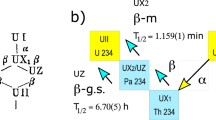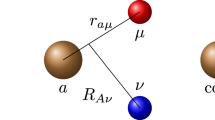Abstract
Correlated basis function (CBF) perturbation theory and the formalism of cluster expansions have been recently employed to obtain an effective interaction from a nuclear Hamiltonian strongly constrained by phenomenology. We report the results of a study of the superfluid gap in pure neutron matter, associated with the formation of Cooper pairs in the \(^1S_0\) channel. The calculations have been carried out using an improved version of the CBF effective interaction, in which three-nucleon forces are taken into account using a microscopic model. Our results show that a non-vanishing superfluid gap develops at densities in the range \(2 \times 10^{-4} \lesssim \rho /\rho _0 \lesssim 0.1\), where \(\rho _0 = 2.8 \times 10^{14}~\mathrm{g~cm}^{-3}\) is the equilibrium density of isospin-symmetric nuclear matter, corresponding mainly to the neutron-star inner crust.





Similar content being viewed by others
References
M.G. Alford, J.W. Clark, A. Sedrakian, Pairing in Fermionic Systems: Basic Concepts and Modern Applications (World Scientific, Singapore, 2006)
L.N. Cooper, Bound electron pairs in a degenerate Fermi gas. Phys. Rev. 104, 1189 (1956)
C.-H. Yang, J.W. Clark, Superfluid condensation energy of neutron matter. Nucl. Phys. A 174, 49 (1971)
N.H. March, W.H. Young, S. Sampanthar, The Many-Body Problem in Quantum Mechanics (Dover Publications, New York, 1967)
D.G. Yakovlev, C.J. Pethick, Neutron star cooling. Annu. Rev. Astron. Astrophys. 42, 169 (2004)
S. Chandrasekhar, Solutions of two problems in the theory of gravitational radiation. Phys. Rev. Lett. 24, 611 (1970)
J.L. Friedman, B.F. Schutz, Lagrangian perturbation theory of nonrelativistic fluids. Astrophys. J. 221, 937 (1978)
N. Andersson, K.D. Kokkotas, The r-mode instability in rotating neutron stars. Int. J. Mod. Phys. D 10, 381 (2001)
N. Andersson, G.L. Comer, K. Glampedakis, How viscous is a superfluid neutron star core? Nucl. Phys. A 763, 212 (2005)
L. Amundsen, E. Østgaard, Superfluidity of neutron matter: (I). Singlet pairing. Nucl. Phys. A 437, 487 (1985)
J. Wambach, T.L. Ainsworth, D. Pines, Quasiparticle interactions in neutron matter for applications in neutron stars. Nucl. Phys. A 555, 128 (1993)
S. Cowell, V.R. Pandharipande, Weak interactions in hot nucleon matter. Phys. Rev. C 73, 025801 (2006)
O. Benhar, M. Valli, Shear viscosity of neutron matter from realistic nucleon–nucleon interactions. Phys. Rev. Lett. 99, 232501 (2007)
A. Lovato, O. Benhar, S. Fantoni, AYu. Illarionov, K.E. Schmidt, Density-dependent nucleon–nucleon interaction from three-nucleon forces. Phys. Rev. C 83, 054003 (2011)
A. Lovato, C. Losa, O. Benhar, Weak response of cold symmetric nuclear matter at three-body cluster level. Nucl. Phys. A 901, 22 (2013)
A. Lovato, O. Benhar, S. Gandolfi, C. Losa, Neutral–current interactions of low-energy neutrinos in dense neutron matter. Phys. Rev. C 89, 025804 (2014)
O. Benhar, A. Polls, M. Valli, I. Vidaña, Microscopic calculations of transport properties of neutron matter. Phys. Rev. C 81, 024305 (2010)
O. Benhar, N. Farina, Correlation effects on the weak response of nuclear matter. Phys. Lett. B 680, 305 (2009)
O. Benhar, A. Cipollone, A. Loreti, Weak response of neutron matter at low momentum transfer. Phys. Rev. C 87, 014601 (2013)
A. Mecca, A. Lovato, O. Benhar, A. Polls, Effective-interaction approach to the Fermi hard-sphere system. Phys. Rev. C 91, 034325 (2015)
A. Mecca, A. Lovato, O. Benhar, A. Polls, Transport properties of the Fermi hard-sphere system. Phys. Rev. C 93, 035802 (2016)
P. Ring, P. Schuck, The Nuclear Many-Body Problem (Springer, Berlin, 1980)
A.L. Fetter, J.D. Walecka, Quantum Theory of Many-Particle Systems (Dover Publications, New York, 2012)
H.F. Zhang, U. Lombardo, W. Zuo, Transport parameters in neutron stars from in-medium \(NN\) cross sections. Phys. Rev. C 82, 015805 (2010)
E. Feenberg, Theory of Quantum Fluids (Academic Press, New York, 1969)
V.R. Pandharipande, R.B. Wiringa, Variations on a theme of nuclear matter. Rev. Mod. Phys. 51, 821 (1979)
J.W. Clark, Variational theory of nuclear matter. Prog. Part. Nucl. Phys. 2, 89 (1979)
A. Fabrocini, S. Fantoni, in First International Course of Condensed Matter Physics, ed. by D. Prosperi, S. Rosati, G. Violini (World Scientific, Singapore, 1986)
S. Fantoni, S. Rosati, Jastrow correlations and an irreducible cluster expansion for infinite boson or fermion systems. Il Nuovo Cimento A 20, 179 (1974)
E. Krotscheck, Fermi-hypernetted chain theory for liquid 3He: a reassessment. J. Low Temp. Phys. 119, 103 (2000)
S. Fantoni, V.R. Pandharipande, Orthogonalization of correlated states. Phys. Rev. C 37, 1697 (1988)
S. Cowell, V.R. Pandharipande, Neutrino mean free paths in cold symmetric nuclear matter. Phys. Rev. C 70, 035801 (2004)
R.B. Wiringa, V.G.J. Stoks, R. Schiavilla, Accurate nucleon–nucleon potential with charge-independence breaking. Phys. Rev. C 51, 38 (1995)
B.S. Pudliner, V.R. Pandharipande, J. Carlson, S.C. Pieper, R.B. Wiringa, Quantum Monte Carlo calculations of nuclei with \(A <\sim 7\). Phys. Rev. C 56, 1720 (1997)
I.E. Lagaris, V.R. Pandharipande, Variational calculations of realistic models of nuclear matter. Nucl. Phys. A 359, 349 (1981)
R.B. Wiringa, S.C. Pieper, Evolution of nuclear spectra with nuclear forces. Phys. Rev. Lett. 89, 182501 (2002)
B.S. Pudliner, V.R. Pandharipande, J. Carlson, R.B. Wiringa, Quantum Monte Carlo calculations of \(A \le 6\) nuclei. Phys. Rev. Lett. 74, 4396 (1995)
J.-I. Fujita, H. Miyazawa, Pion theory of three-body forces. Prog. Theor. Phys. 17, 360 (1957)
K.E. Schmidt, S. Fantoni, A quantum Monte Carlo method for nucleon systems. Phys. Lett. B 446, 99 (1999)
J. Bardeen, L.N. Cooper, J.R. Schrieffer, Theory of superconductivity. Phys. Rev. 108, 1175 (1957)
E. Krotscheck, J.W. Clark, Studies in the method of correlated basis functions: (III). Pair condensation in strongly interacting Fermi systems. Nucl. Phys. A 333, 77 (1980)
V.A. Khodel, V.V. Khodel, J.W. Clark, Solution of the gap equation in neutron matter. Nucl. Phys. A 598, 390 (1996)
D.R. Tilley, J. Tilley, Superfluidity and Superconductivity (CRC Press, Boca Raton, 1990)
J.M.C. Chen, J.W. Clark, R.D. Davé, V.V. Khodel, Pairing gaps in nucleonic superfluids. Nucl. Phys. A 555, 59 (1993)
J. Rikovska Stone, J.C. Miller, R. Koncewicz, P.D. Stevenson, M.R. Strayer, Nuclear matter and neutron-star properties calculated with the Skyrme interaction. Phys. Rev. C 68, 034324 (2003)
E. Chabanat, P. Bonche, P. Haensel, J. Meyer, R. Schaeffer, A Skyrme parametrization from subnuclear to neutron star densities. Nucl. Phys. A 627, 710 (1997)
N. Chamel, P. Haensel, Physics of neutron star crusts. Living Rev. Relativ. 11, 10 (2008)
Acknowledgements
This research was supported by the Italian National Institute for Nuclear Research (INFN) Under Grant MANYBODY.
Author information
Authors and Affiliations
Corresponding author
Rights and permissions
About this article
Cite this article
Benhar, O., De Rosi, G. Superfluid Gap in Neutron Matter from a Microscopic Effective Interaction. J Low Temp Phys 189, 250–261 (2017). https://doi.org/10.1007/s10909-017-1823-x
Received:
Accepted:
Published:
Issue Date:
DOI: https://doi.org/10.1007/s10909-017-1823-x




